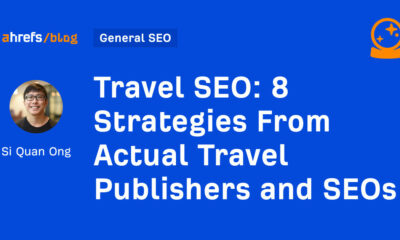SOCIAL
Meta Looks Set to Push Publishers Towards Short Video in New Pivot

Hi news publishers, it’s me, Facebook – you may remember me from my previous hits including ‘pivot to video’ and ‘prioritizing content from family and friends’.
In the latest reminder that news organizations, or publishers and brands in general, should not trust Meta to provide them with ongoing audience reach, the company is once again re-considering how it promotes news content in the app, with The Information reporting that Meta’s now looking to push news organizations towards short video, where it’s seeing the most growth in user engagement.
As per The Information:
“Meta Platforms is considering reducing the money it gives news organizations as it reevaluates the partnerships it struck over the past few years, according to people familiar with the matter. The reassessment comes as Meta looks to cut costs broadly and rethinks the value of including news in its flagship Facebook app.”
Meta has been using grants and other partnership initiatives to establish better links with news providers, in order to ensure they keep posting their content to its apps – and keep users more engaged as a result.
Meta’s most recent push on this front has been its dedicated News tab, which it’s used as an enticement to establish direct partnerships with publishers, while also sharing a percentage of revenue with these organizations.
That, in itself, has been a key point of contention, with governments in several countries pushing Meta to share more of its revenue with publishers via new ‘fair use’ policies and regulations, as a result of Meta and Google’s digital ad dominance, and its subsequent impact on local publishing markets.
The most high-profile example on this front was in Australia, where Facebook temporarily banned news publishers entirely for a period last year due to disagreement over its obligations to share revenue with these organizations.
Meta has been able to negotiate new arrangements around such policies, but a key focus of that truce has been enhanced exposure for news publishers in the app, which Meta has sought to provide via its News tab.
Now, it seems that this may change again, which could cause major headaches for news organizations around the world.
Of course, short-form video is where Meta wants to see more activity, so it makes sense to see it pushing news orgs in this direction. As part of its most recent earnings call, Meta CEO Mark Zuckerberg noted that Reels now makes up more than 20% of the time that people spend on Instagram, while video, overall, makes up 50% of the time that users spend on Facebook.
You can see, then, why Meta is moving in this direction, and with user engagement on the decline overall, it needs to start pulling all the levers that it can to keep people in its apps, instead of drifting off to TikTok instead.
In addition to this, Meta also says that fewer people have been clicking on links to news articles since President Donald Trump left office. Referral links don’t provide as much direct engagement value to Meta either way, and when you take in the overall trends, it makes sense that Meta would look to push publishers in the direction of short video instead.
It just means that publishers will now be faced with a new ‘pivot to video’. Which didn’t work out very well for them last time.
Indeed, many publishers were forced to lay-off staff in the previous video shift, which turned again once Meta stopped seeing engagement growth from video, and reduced the reach of such content via algorithm amplification.
Pivoting, once again, will trigger PTSD for many staffers, while it also serves as a reminder that Meta isn’t really looking to help publishers with its various changes, it’s looking to help itself. How you deal with that is your problem.
Of course, Meta’s running a business in an increasingly competitive space, so it needs to change strategic direction in line with the latest shifts. But again, it’s another reminder that you shouldn’t build on ‘rented land’, and that you can’t rely on Facebook or Instagram reach as a means to maximize your business.
This goes for all publishers, and all brands – you’re much better off building your own email lists and distribution channels, and using them as your core focus, than you are in relying on social media networks to amplify your content.
Definitely, social apps can provide major benefits in this respect, but they can and will change focus without warning, which could leave you in a world of pain as a result.
We’ll wait to see if Meta does, in fact, push for a new video pivot.
SOCIAL
12 Proven Methods to Make Money Blogging in 2024

 This is a contributed article.
This is a contributed article.
The world of blogging continues to thrive in 2024, offering a compelling avenue for creative minds to share their knowledge, build an audience, and even turn their passion into profit. Whether you’re a seasoned blogger or just starting, there are numerous effective strategies to monetize your blog and achieve financial success. Here, we delve into 12 proven methods to make money blogging in 2024:
1. Embrace Niche Expertise:
Standing out in the vast blogosphere requires focus. Carving a niche allows you to cater to a specific audience with targeted content. This not only builds a loyal following but also positions you as an authority in your chosen field. Whether it’s gardening techniques, travel hacking tips, or the intricacies of cryptocurrency, delve deep into a subject you’re passionate and knowledgeable about. Targeted audiences are more receptive to monetization efforts, making them ideal for success.
2. Content is King (and Queen):
High-quality content remains the cornerstone of any successful blog. In 2024, readers crave informative, engaging, and well-written content that solves their problems, answers their questions, or entertains them. Invest time in crafting valuable blog posts, articles, or videos that resonate with your target audience.
- Focus on evergreen content: Create content that remains relevant for a long time, attracting consistent traffic and boosting your earning potential.
- Incorporate multimedia: Spice up your content with captivating images, infographics, or even videos to enhance reader engagement and improve SEO.
- Maintain consistency: Develop a regular publishing schedule to build anticipation and keep your audience coming back for more.
3. The Power of SEO:
Search Engine Optimization (SEO) ensures your blog ranks high in search engine results for relevant keywords. This increases organic traffic, the lifeblood of any monetization strategy.
- Keyword research: Use keyword research tools to identify terms your target audience searches for. Strategically incorporate these keywords into your content naturally.
- Technical SEO: Optimize your blog’s loading speed, mobile responsiveness, and overall technical aspects to improve search engine ranking.
- Backlink building: Encourage other websites to link back to your content, boosting your blog’s authority in the eyes of search engines.
4. Monetization Magic: Affiliate Marketing
Affiliate marketing allows you to earn commissions by promoting other companies’ products or services. When a reader clicks on your affiliate link and makes a purchase, you get a commission.
- Choose relevant affiliates: Promote products or services that align with your niche and resonate with your audience.
- Transparency is key: Disclose your affiliate relationships clearly to your readers and build trust.
- Integrate strategically: Don’t just bombard readers with links. Weave affiliate promotions naturally into your content, highlighting the value proposition.
5. Display Advertising: A Classic Approach
Display advertising involves placing banner ads, text ads, or other visual elements on your blog. When a reader clicks on an ad, you earn revenue.
- Choose reputable ad networks: Partner with established ad networks that offer competitive rates and relevant ads for your audience.
- Strategic ad placement: Place ads thoughtfully, avoiding an overwhelming experience for readers.
- Track your performance: Monitor ad clicks and conversions to measure the effectiveness of your ad placements and optimize for better results.
6. Offer Premium Content:
Providing exclusive, in-depth content behind a paywall can generate additional income. This could be premium blog posts, ebooks, online courses, or webinars.
- Deliver exceptional value: Ensure your premium content offers significant value that justifies the price tag.
- Multiple pricing options: Consider offering tiered subscription plans to cater to different audience needs and budgets.
- Promote effectively: Highlight the benefits of your premium content and encourage readers to subscribe.
7. Coaching and Consulting:
Leverage your expertise by offering coaching or consulting services related to your niche. Readers who find your content valuable may be interested in personalized guidance.
- Position yourself as an expert: Showcase your qualifications, experience, and client testimonials to build trust and establish your credibility.
- Offer free consultations: Provide a limited free consultation to potential clients, allowing them to experience your expertise firsthand.
- Develop clear packages: Outline different coaching or consulting packages with varying time commitments and pricing structures.
8. The Power of Community: Online Events and Webinars
Host online events or webinars related to your niche. These events offer valuable content while also providing an opportunity to promote other monetization avenues.
- Interactive and engaging: Structure your online events to be interactive with polls, Q&A sessions, or live chats. Click here to learn more about image marketing with Q&A sessions and live chats.
9. Embrace the Power of Email Marketing:
Building an email list allows you to foster stronger relationships with your audience and promote your content and offerings directly.
- Offer valuable incentives: Encourage readers to subscribe by offering exclusive content, discounts, or early access to new products.
- Segmentation is key: Segment your email list based on reader interests to send targeted campaigns that resonate more effectively.
- Regular communication: Maintain consistent communication with your subscribers through engaging newsletters or updates.
10. Sell Your Own Products:
Take your expertise to the next level by creating and selling your own products. This could be physical merchandise, digital downloads, or even printables related to your niche.
- Identify audience needs: Develop products that address the specific needs and desires of your target audience.
- High-quality offerings: Invest in creating high-quality products that offer exceptional value and user experience.
- Utilize multiple platforms: Sell your products through your blog, online marketplaces, or even social media platforms.
11. Sponsorships and Brand Collaborations:
Partner with brands or businesses relevant to your niche for sponsored content or collaborations. This can be a lucrative way to leverage your audience and generate income.
- Maintain editorial control: While working with sponsors, ensure you retain editorial control to maintain your blog’s authenticity and audience trust.
- Disclosures are essential: Clearly disclose sponsored content to readers, upholding transparency and ethical practices.
- Align with your niche: Partner with brands that complement your content and resonate with your audience.
12. Freelancing and Paid Writing Opportunities:
Your blog can serve as a springboard for freelance writing opportunities. Showcase your writing skills and expertise through your blog content, attracting potential clients.
- Target relevant publications: Identify online publications, websites, or magazines related to your niche and pitch your writing services.
- High-quality samples: Include high-quality blog posts from your site as writing samples when pitching to potential clients.
- Develop strong writing skills: Continuously hone your writing skills and stay updated on current trends in your niche to deliver exceptional work.
Conclusion:
Building a successful blog that generates income requires dedication, strategic planning, and high-quality content. In today’s digital age, there are numerous opportunities to make money online through blogging. By utilizing a combination of methods such as affiliate marketing, sponsored content, and selling digital products or services, you can leverage your blog’s potential and achieve financial success.
Remember, consistency in posting, engaging with your audience, and staying adaptable to trends are key to thriving in the ever-evolving blogosphere. Embrace new strategies, refine your approaches, and always keep your readers at the forefront of your content creation journey. With dedication and the right approach, your blog has the potential to become a valuable source of income and a platform for sharing your knowledge and passion with the world, making money online while doing what you love.
Image Credit: DepositPhotos
SOCIAL
Snapchat Explores New Messaging Retention Feature: A Game-Changer or Risky Move?

In a recent announcement, Snapchat revealed a groundbreaking update that challenges its traditional design ethos. The platform is experimenting with an option that allows users to defy the 24-hour auto-delete rule, a feature synonymous with Snapchat’s ephemeral messaging model.
The proposed change aims to introduce a “Never delete” option in messaging retention settings, aligning Snapchat more closely with conventional messaging apps. While this move may blur Snapchat’s distinctive selling point, Snap appears convinced of its necessity.
According to Snap, the decision stems from user feedback and a commitment to innovation based on user needs. The company aims to provide greater flexibility and control over conversations, catering to the preferences of its community.
Currently undergoing trials in select markets, the new feature empowers users to adjust retention settings on a conversation-by-conversation basis. Flexibility remains paramount, with participants able to modify settings within chats and receive in-chat notifications to ensure transparency.
Snapchat underscores that the default auto-delete feature will persist, reinforcing its design philosophy centered on ephemerality. However, with the app gaining traction as a primary messaging platform, the option offers users a means to preserve longer chat histories.
The update marks a pivotal moment for Snapchat, renowned for its disappearing message premise, especially popular among younger demographics. Retaining this focus has been pivotal to Snapchat’s identity, but the shift suggests a broader strategy aimed at diversifying its user base.
This strategy may appeal particularly to older demographics, potentially extending Snapchat’s relevance as users age. By emulating features of conventional messaging platforms, Snapchat seeks to enhance its appeal and broaden its reach.
Yet, the introduction of message retention poses questions about Snapchat’s uniqueness. While addressing user demands, the risk of diluting Snapchat’s distinctiveness looms large.
As Snapchat ventures into uncharted territory, the outcome of this experiment remains uncertain. Will message retention propel Snapchat to new heights, or will it compromise the platform’s uniqueness?
Only time will tell.
SOCIAL
Catering to specific audience boosts your business, says accountant turned coach

While it is tempting to try to appeal to a broad audience, the founder of alcohol-free coaching service Just the Tonic, Sandra Parker, believes the best thing you can do for your business is focus on your niche. Here’s how she did just that.
When running a business, reaching out to as many clients as possible can be tempting. But it also risks making your marketing “too generic,” warns Sandra Parker, the founder of Just The Tonic Coaching.
“From the very start of my business, I knew exactly who I could help and who I couldn’t,” Parker told My Biggest Lessons.
Parker struggled with alcohol dependence as a young professional. Today, her business targets high-achieving individuals who face challenges similar to those she had early in her career.
“I understand their frustrations, I understand their fears, and I understand their coping mechanisms and the stories they’re telling themselves,” Parker said. “Because of that, I’m able to market very effectively, to speak in a language that they understand, and am able to reach them.”Â
“I believe that it’s really important that you know exactly who your customer or your client is, and you target them, and you resist the temptation to make your marketing too generic to try and reach everyone,” she explained.
“If you speak specifically to your target clients, you will reach them, and I believe that’s the way that you’re going to be more successful.
Watch the video for more of Sandra Parker’s biggest lessons.
-
SEARCHENGINES7 days ago
Daily Search Forum Recap: August 26, 2024
-
SEARCHENGINES6 days ago
Daily Search Forum Recap: August 27, 2024
-

 WORDPRESS7 days ago
WORDPRESS7 days ago9 Best Elementor Alternatives 2024 (Faster Page Builders)
-
SEARCHENGINES5 days ago
Daily Search Forum Recap: August 28, 2024
-

 SEO6 days ago
SEO6 days agoIs Value-Based Bidding Your Ticket To Higher Quality Leads?
-

 WORDPRESS6 days ago
WORDPRESS6 days agoNew WordPress.com Themes for August 2024 – WordPress.com News
-

 WORDPRESS5 days ago
WORDPRESS5 days agoBeginner’s Guide to Social Commerce for WordPress Users
-

 SEO4 days ago
SEO4 days agoHere’s How You Can Outsource SEO Easily and Effectively (+ Best Practices)














You must be logged in to post a comment Login